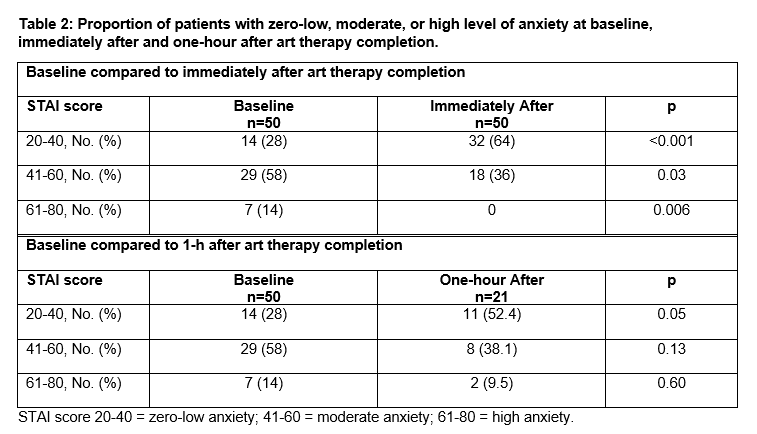Emergency Medicine: All Areas
Category: Abstract Submission
Emergency Medicine X
383 - Effectiveness of Art Therapy Interventions for Treating Pain and Anxiety in Adolescents in the Emergency Department
Sunday, April 24, 2022
3:30 PM - 6:00 PM US MT
Poster Number: 383
Publication Number: 383.314
Publication Number: 383.314
Susanne M. Bifano, NewYork-Presbyterian Morgan Stanley Children's Hospital, New York, NY, United States; Daniel S. Tsze, Columbia University Vagelos College of Physicians and Surgeons, New York, NY, United States

Susanne M. Bifano, M.S.Ed, M.P.S. (she/her/hers)
Art Therapist
NewYork-Presbyterian Morgan Stanley Children's Hospital
New York, New York, United States
Presenting Author(s)
Background: Pain and anxiety are commonly experienced by patients presenting to the emergency department (ED) and may be managed using pharmacologic and/or integrative interventions, the latter of which may have multiple benefits but is understudied. Art therapy is one such integrative intervention that is safe, free from side effects associated with pharmacologic interventions, and shown to decrease pain and anxiety. However, it has not been studied in adolescents being cared for in the ED setting.
Objective: To determine the degree that art therapy reduces pain and anxiety in adolescents being treated in the ED immediately and 1h after art therapy completion, and to describe their qualitative experiences of pain and anxiety in response to receiving art therapy.
Design/Methods: Prospective observational study of patients 12-18 years old presenting to a pediatric ED with a painful condition and self-reported pain score of ≥4 /10. Art therapy was administered by a licensed and board-certified art therapist. Pain intensity was measured using the Verbal Numerical Rating Scale (scored 0-10; change of ≥2/10=clinically significant) and anxiety was measured using the State-Trait Anxiety Inventory (scored 20-80; score of 20-40=zero-low anxiety; 41-60=moderate anxiety). Outcomes were measured at baseline and immediately after and 1h after art therapy completion. A standardized interview was conducted immediately after completion of art therapy to assess each patient’s qualitative experience.
Results: We enrolled 50 patients; 50 and 21 patients were analyzed for outcomes assessed immediately and 1h after art therapy completion, respectively; 50 underwent the standardized interview. Mean duration of art therapy was 34.7 min. Mean baseline pain intensity was 6.2 and decreased by 1.3 (p < .001) and 1.5 (p=.006) immediately after and 1h after art therapy completion, respectively. Median baseline anxiety was 47 and decreased to 37 (p < .001) and 40 (p=.12) at the same time points, respectively. Forty-eight patients (96%) reported feelings of relaxation, decreased pain intensity, and/or empowerment (e.g. “Very relaxing”; “Soothed my mind”; “I didn’t feel as much pain”; “Made me forget that my jaw was hurting”; “Really showed my emotions”; “A way to explain to doctors what I’m feeling and what parts hurt”).Conclusion(s): Art therapy was not associated with clinically significant decreases in pain, but was associated with qualitative improvements in pain and clinically significant and qualitative improvements in anxiety immediately after intervention completion.
Table 1: Patient characteristics.png)
Table 2: Proportion of patients with zero-low, moderate, or high level of anxiety at baseline, immediately after and one-hour after art therapy completion.
Objective: To determine the degree that art therapy reduces pain and anxiety in adolescents being treated in the ED immediately and 1h after art therapy completion, and to describe their qualitative experiences of pain and anxiety in response to receiving art therapy.
Design/Methods: Prospective observational study of patients 12-18 years old presenting to a pediatric ED with a painful condition and self-reported pain score of ≥4 /10. Art therapy was administered by a licensed and board-certified art therapist. Pain intensity was measured using the Verbal Numerical Rating Scale (scored 0-10; change of ≥2/10=clinically significant) and anxiety was measured using the State-Trait Anxiety Inventory (scored 20-80; score of 20-40=zero-low anxiety; 41-60=moderate anxiety). Outcomes were measured at baseline and immediately after and 1h after art therapy completion. A standardized interview was conducted immediately after completion of art therapy to assess each patient’s qualitative experience.
Results: We enrolled 50 patients; 50 and 21 patients were analyzed for outcomes assessed immediately and 1h after art therapy completion, respectively; 50 underwent the standardized interview. Mean duration of art therapy was 34.7 min. Mean baseline pain intensity was 6.2 and decreased by 1.3 (p < .001) and 1.5 (p=.006) immediately after and 1h after art therapy completion, respectively. Median baseline anxiety was 47 and decreased to 37 (p < .001) and 40 (p=.12) at the same time points, respectively. Forty-eight patients (96%) reported feelings of relaxation, decreased pain intensity, and/or empowerment (e.g. “Very relaxing”; “Soothed my mind”; “I didn’t feel as much pain”; “Made me forget that my jaw was hurting”; “Really showed my emotions”; “A way to explain to doctors what I’m feeling and what parts hurt”).Conclusion(s): Art therapy was not associated with clinically significant decreases in pain, but was associated with qualitative improvements in pain and clinically significant and qualitative improvements in anxiety immediately after intervention completion.
Table 1: Patient characteristics
.png)
Table 2: Proportion of patients with zero-low, moderate, or high level of anxiety at baseline, immediately after and one-hour after art therapy completion.

